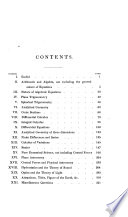 | Mathematics - 1836 - 366 pages
...of the roots of it and all its successive limiting equations is equal to — p. - — jj — . A 70. No equation can have more positive roots than it has changes of sign, nor more negative roots than it has continuations of the same sign. If one term be wanting, what inference... | |
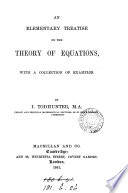 | Isaac Todhunter - Equations, Theory of - 1861 - 330 pages
...the factor corresponding to each positive root we introduce at least one change of sign. Therefore no equation can have more positive roots than it has changes of sign. To prove the second part of Descartes's rule of signs we suppose the equation complete, and put —... | |
 | Isaac Todhunter - Algebra - 1875 - 344 pages
...the factor corresponding to each positive root we introduce at least one change of sign. Therefore no equation can have more positive roots than it has changes of sign. To prove the second part of Descartes's rule of signs we suppose the equation complete, and put —... | |
 | William Snow Burnside, Arthur William Panton - Determinants - 1881 - 407 pages
...equation, to assign a superior limit to the number of its positive roots, may be enunciated as follows :—No equation can have more positive roots than it has changes of sign from + to -, and from - to -f, in the terms of its first member. "We shall content ourselves for the present with the proof fchich... | |
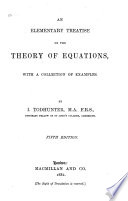 | Isaac Todhunter - Equations - 1882 - 348 pages
...the factor corresponding to each positive root we introduce at least one change of sign. Therefore no equation can have more positive roots than it has changes of sign. To prove the second part of Descartes's rule of signs we suppose the equation complete, and put —... | |
 | William Snow Burnside, Arthur William Panton - Determinants - 1886 - 474 pages
...to assign a superior limit to the number of its positive roots, may be enunciated as follows : — No equation can have more positive roots than it has...sign from + to -, and from — to +, in the terms of its first member. We shall content ourselves for the present with the proof which is usually given,... | |
 | William Snow Burnside, Arthur William Panton - Determinants - 1886 - 478 pages
...to assign a superior limit to the number of its positive roots, may be enunciated as follows : — No equation can have more positive roots than it has...sign from + to —, and from - to +, in the terms of its first member. We shall content ourselves for the present with the proof which is usually given,... | |
 | Henry Sinclair Hall, Samuel Ratcliffe Knight - Algebra - 1891 - 606 pages
...each factor x — a corresponding to a positive root introduces at least one change of sign; therefore no equation can have more positive roots than it has changes of sign. Again, the roots of the equation f(—x) = 0 are equal to those of f(x) = Q but opposite to them in... | |
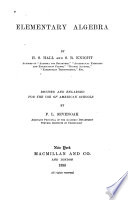 | Henry Sinclair Hall, Samuel Ratcliffe Knight - Algebra - 1895 - 508 pages
...each factor x— a corresponding to a positive root introduces at least one change of sign ; therefore no equation can have more positive roots than it has changes of sign. To prove the second part of Descartes' Rule, let us suppose the equation complete and substitute —... | |
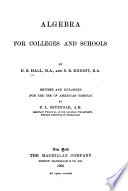 | Henry Sinclair Hall, Samuel Ratcliffe Knight - Algebra - 1897 - 552 pages
...each factor x—a corresponding to a positive root introduces at least one change of sign ; therefore no equation can have more positive roots than it has changes of sign. To prove the second part of Descartes' Eule, let us suppose the equation complete and substitute —... | |
| |